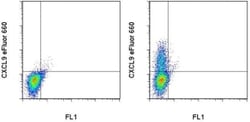Learn More
Invitrogen™ CXCL9 (MIG) Monoclonal Antibody (MIG-2F5.5), eFluor™ 660, eBioscience™
Armenian Hamster Monoclonal Antibody
Supplier: Invitrogen™ 50300980

Description
Description: The monoclonal antibody MIG-2F5.5 reacts with mouse monokine induced by IFN gamma (mig, mig-1, CXCL9). This 14.4 kDa inflammatory chemokine is specifically induced by IFN gamma, but not other activators such as LPS or IFN alpha. Secretion of mig, mainly by macrophages results in the chemotaxis of a variety of activated T cells via the CXCR3 chemokine receptor. Mig is involved many areas of research including autoimmune diseases, cancer, and inflammation. Applications Reported: This MIG-2F5.5 antibody has been reported for use in intracellular staining followed by flow cytometric analysis. Applications Tested: This MIG-2F5.5 antibody has been tested by intracellular staining and flow cytometric analysis of stimulated RAW 264.7 cells. This can be used at less than or equal to 0.25 μg per test. A test is defined as the amount (μg) of antibody that will stain a cell sample in a final volume of 100 μL. Cell number should be determined empirically but can range from 10^5 to 10^8 cells/test. It is recommended that the antibody be carefully titrated for optimal performance in the assay of interest. eFluor® 660 is a replacement for Alexa Fluor® 647. eFluor® 660 emits at 659 nm and is excited with the red laser (633 nm). Please make sure that your instrument is capable of detecting this fluorochome. Excitation: 633-647 nm; Emission: 668 nm; Laser: Red Laser. Filtration: 0.2 μm post-manufacturing filtered.
MIG, also known as CXCL9, is a T-cell chemoattractant inducible by gamma interferon that is a member of the CXC chemokine family of cytokines.This gene is mapped to 4q21. It is noted that, although the best-described activities of the chemokines are as chemotactic factors, chemokines also have an effect on T-cell activation, angiogenesis, and HIV infection. While most CXC chemokines are chemotactic for neutrophils, MIG and INP10 are unusual and similar in being CXC chemokines that are chemotactic for lymphocytes and inactive in neutrophils.
Specifications
| CXCL9 (MIG) | |
| Monoclonal | |
| 0.2 mg/mL | |
| PBS with 0.09% sodium azide; pH 7.2 | |
| P18340 | |
| CXCL9 | |
| Affinity chromatography | |
| RUO | |
| 17329 | |
| 4°C, store in dark, DO NOT FREEZE! | |
| Liquid |
| Flow Cytometry | |
| MIG-2F5.5 | |
| eFluor 660 | |
| CXCL9 | |
| BB139920; C Cmotif chemokine; C X C motif chemokine; CC motif chemokine; CCmotif chemokine; chemokine (C-X-C motif) ligand 9; CMK; crg-10; CXC; CXC motif chemokine; C-X-C motif chemokine 9; C-X-C motif chemokine ligand 9; CXCL; CXCL9; gamma interferon-induced monokine; gamma-interferon-induced monokine; HuMIG; M119; Mig; monokine induced by gamma interferon; monokine induced by interferon gamma; monokine induced by interferon-gamma; MuMIG; protein m119; SCYB9; small inducible cytokine B subfamily (Cys-X-Cys), member 9; small inducible cytokine B9; small-inducible cytokine B9 | |
| Armenian Hamster | |
| 25 μg | |
| Primary | |
| Mouse | |
| Antibody | |
| IgG |
The Fisher Scientific Encompass Program offers items which are not part of our distribution portfolio. These products typically do not have pictures or detailed descriptions. However, we are committed to improving your shopping experience. Please use the form below to provide feedback related to the content on this product.

